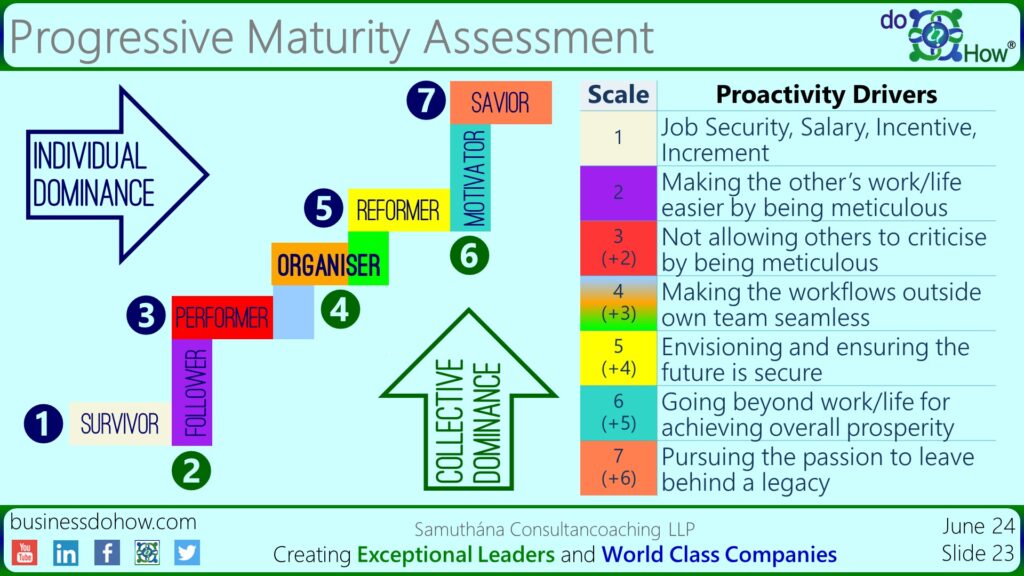Progressive Maturity Assessment by Dinakar murthy

In today’s world, star ratings have become almost second nature when it comes to selecting products or booking hotels on various eCommerce platforms. Ratings provide a glimpse into the perceived quality of a product or hotel based on the experiences of previous customers. On the other hand, assessment serves as a valuable tool for identifying the next steps in development. The key lies in using a scale that can serve both assessment purposes and guide measures toward achieving a higher maturity level.
Today, I’ll be sharing various maturity assessment models that I’ve encountered, with a focus on explaining the doHow® maturity assessment model for a clearer understanding.
Back in 1986, my first encounter with an annual appraisal used a range from 1 to 5, where 1 represented “Not Fit” and 5 represented “Exceptional.” Over time, this scale evolved to include more nuanced descriptors, such as “Always below expectation” to “Always exceeds expectation,” in an effort to introduce objectivity.
The Capability Maturity Model Integration (CMMI) maturity model, established in the 1990s, consists of six levels, ranging from 0 (Incomplete) to 5 (Optimizing). Widely adopted, this model is instrumental in building process-based organizations for consistent outcomes, serving as the foundation for business process management today.
Manufacturing companies often use the 5S model, mirroring the CMMI model with levels from 0 (Disorganized) to 5 (Sustained). Business excellence models from the 2000s, derived from the CMMI model, typically feature five stages ranging from 0% (Inability to achieve) to 90-100% (Outstanding ability to achieve).
Even the ZED (Zero Effect Zero Defect) model, developed by the Government of India for manufacturing, utilizes a scale based on the CMMI model with five levels from 1 (Struggler) to 5 (World Class).
While these models are prevalent, they often require considerable expertise for accurate assessment. Drawing inspiration from developmental psychology, particularly the Spiral Dynamics (SD) model, the doHow® maturity assessment model merges elements from both CMMI and SD, defining seven maturity levels.
1. Survivor:
– Ignorance of practice/competency
– Proactive when survival is at risk
– Assuming awareness of practice/competency
– Believing knowing is doing
2. Follower:
– Awareness of practice/competency
– Proactive when companionship is at risk
– Acknowledging maturity
– Wanting to learn and improve
3. Performer:
– Learner of practice/competency
– Proactive when reputation is at risk
– Consciously learning competencies/skills
– Making notes during discussions
4. Organizer:
– Good in practice/competency
– Proactive when clockwork is at risk
– Performing consistently
– Comparing benchmarks
– Structured and disciplined working
5. Reformer:
– Fluid in practice/competency
– Proactive when future is at risk
– Continually changing and improving
– Creating standards for comparing and scaling
6. Motivator:
– Coach for practice/competency
– Proactive when prosperity is at risk
– Triggering thinking and reflecting for learning
– Regular routine reporting and reviewing
7. Saviour:
– Master for practice/competency
– Proactive when legacy is at risk
– Developing inclusive purpose/vision/values/strategies
– Building continually learning culture
– Regular auditing
This model proves effective in self-assessment, other individuals, teams, and organisations, as it aligns key drivers for behaviour with maturity levels, providing a comprehensive understanding. Additionally, the validation of lower levels before progressing to the next level, performer onwards, promotes sustainable development, moving away from the common tendency to spike performance only during assessments.
As you reflect on your own practices, which model do you use to assess maturity, encouraging a natural inclination toward
continual learning and improvement?
Happy reading!






Responses